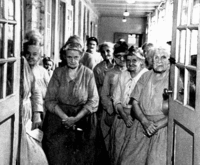This week's blog is a hard one for me to write. I am admitting to the world that I'll be retiring in a couple weeks. Don't get me wrong. I'm thrilled to be quitting my job, but being old enough to retire is another matter.
Since I spend half of my life submerged in the 1920s-30s (just ask my husband), I decided to look into the topic of old age - not that I'm old. I found out lots of interesting information I'd like to share with you.
Life expectancy charts in 1930 predicted that men would live to age 58 and women to age 62. That means if I were living back then, I would have been measuring my coffin size this week. With a bit more research, I found out the reason those ages were so low was the infant mortality rate. Because so many children died before the age of 21, the life expectancy charts were not accurate. Whew!
Other statistics more accurately explain the life expectancy rate of people living in the early part of the 20th Century. These charts are based on people who actually lived through their childhood years. In 1940, 60.6% of the people who made it to 21 survived to age 65. Of that group of people, the women were expected to live 14.7 years longer and the men to live 13 years longer. So that would give me more hope.
There was no Social Security check coming in the door after a person retired, so people didn't have the option to retire at all. Most men worked until they were physically unable to work because the money was needed for survival. In other words, there were no retirement years to look forward to. Most people worked until they died.
In fact, some companies, railroads among them, started offering the elderly workers pensions because having them around got too dangerous on the job site. For the railroads, mandatory retirement was at age 70 with a pension from the company paid out after that. According to that, I have several more years to work before I can retire. Now I am depressed!
Then came the Depression. That changed things. People lost their jobs way before retirement age. Many older people moved in with their families because they had no other way to cope with the lack of funds.
When the elderly didn't have families to support them they had to move to the county poor house. There the elderly and infirm were institutionalized by the government and housed until they died. If they were physically able, the men participated in the farm work growing food for the people living in these institutions. The women were assigned to housekeeping duties until they couldn't manage it anymore. By all accounts that I saw, this was an awful situation to find yourself.
That was a big reason the government had to get involved in support of older people. By 1935 the government created a program called Old Age Assistance(OAA), which gave every man and woman $20.00 per month, matched by state funds. These funds helped the elderly stay in their own homes longer. OAA prohibited money to be paid to public institutions, including the poor houses. That was a way to get the poor houses closed down.
If the elderly were not able to care for themselves at home any longer, the $40.00 per month could be used toward their support in a group home setting. This was the birth of the "old folks home". These for-profit facilities sprung up quickly to accommodate the large number of elderly needing a place to live and not able to care for themselves. The OAA recipients were paid in cash, which was in short supply during the 30s, so people were eager to use unneeded bedrooms in their homes for that purpose and established these needed nursing homes to house the elderly.
And of course, we all know about the other program - Social Security - that started up in 1942. Social Security payments eventually took the place of OAA payments. Since that time the plight of elderly has improved dramatically.
After doing all this research of the elderly during the 1930s, I'm feeling much better about my age. Sixty three isn't old at all! In fact, I'll probably go out after I retire and kick up my heels to celebrate how young I am. Have a great week!
Information taken from several websites including: Economic History of Retirement in the United States and Elder Web


Interesting that the overall mortality was affected by infant mortality. That explains why so many people lived to a ripe old age in previous centuries when they supposedly should be long dead.
ReplyDeleteYes, I thought that was interesting also. Makes sense since so many babies and children died.
Delete